| |
(Let light be the master of its own destiny)
by Allan W Snyder and François Ladouceur
The present on-going revolution in photonics could see its summit
with the ultimate all-optical device. Simply imagine a transparent
cube like that of Fig. 1 with a myriad of interconnections and
components created by light alone. This is our dream. Circuits
that lie on top of one another and are reconfigurable. Virtual
circuitry. No physical "wires". Either light itself
directs and manipulates light without any intervening fabricated
components such as optical waveguides, or light is used to write
ideal optical components and circuitry in photosensitive materials.
Light controls its own destiny.
The story of guiding light with light and of creating virtual
circuitry is not just about an emerging technology and the ingenious
efforts on the part of many who are presently attempting to make
it a reality. Research into this field has also revealed new conceptual
and experimental approaches for understanding how curious light
beams, known as optical spatial solitons, can be made to remain
localized in space while performing some rather amazing acrobatics.
Advances of late have been remarkably swift, coming from different
groups across the globe: Spatial solitons, once the domain of
high power lasers, can now be launched by an incandescent light
bulb. Soliton dynamics, once the province of esoteric mathematics,
is now accessible with undergraduate physics. Mere theoretical
predictions of a few years ago, such as the possibility of one
soliton being made to spiral about another, the fusion or the
creation of solitons upon collision, and the transportation of
a dim beam by a bright beam are now readily observable in the
laboratory. Even popular science magazines have questioned whether
fabricated optical components would eventually become obsolete
for device applications.
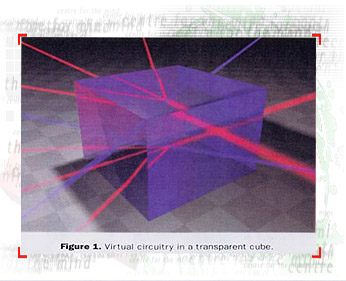
This article conveys the conceptual aspects of light guiding
light by using the simplest known models. It also speculates on
future applications once all the bugs are ironed out, although
we are here limited only by our imagination.
Solitons from a Linear Perspective
As we said, the building blocks for light guiding
light are free-standing beams, known as spatial solitons. Unlike
linear waves which diffract, solitons create their own channel
as they travel in a uniform nonlinear medium, remaining localized
and preserving their shape. Beams in a linear medium do not influence
each other. But solitons can attract, repel, spiral around each
other and this interaction can even be described by the classical
force laws treating the beams as particles with mass. Whereas
linear waves always pass through one another, solitons can be
dramatically altered by collisions. They can annihilate one another,
fuse (Fig. 2) or give birth to multiple solitons.
These phenomena turn out to be of potential importance to the
emerging technology of light guiding light and light written circuitry.
Clearly, we need to have a physical understanding of solitons.
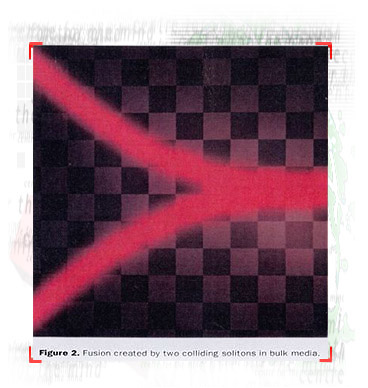
To set the stage, we recall the physics of optical waveguides.
Optical beams have an innate tendency to spread as they propagate
in a homogeneous medium. However, this beam diffraction can be
compensated for by the lens like action of beam refraction, if
the refractive index is increased in the region of the beam. The
resulting optical waveguide provides a balance between diffraction
and refraction.
Spatial solitons can also be understood from this familiar perspective.
Conceptually speaking, nonlinear beams interact with matter to
create their own waveguides. This occurs because the refractive
index of a nonlinear medium depends on the physical properties
of the light beam. We emphasize that these induced waveguides
are composed of linear material and are of arbitrary shape, even
twisted and contorted. Beams then propagate along their own induced
waveguide according to the familiar physics of linear optics.
Of course, if you change the initial conditions, then you change
the form of the induced waveguide.
From this elementary perspective, we can appreciate that disparate
types of solitons are actually the same animal. In the simplest
case, a soliton is one mode of the waveguide it induces. This
describes the classical optical soliton of Chaio, Garmire and
Townes as well as the more esoteric solitons such as the so-called
vortex solitons. More generally, a soliton can be two or more
modes of the induced waveguide. This elaboration explains interesting
soliton dynamics, incoherent solitons, multi-humped solitons and
the coexistence of different classes of solitons.
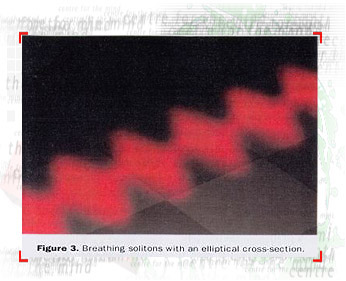
Now, if a soliton can be composed of a number of modes, each
travelling at a different speed, then it should be possible to
decompose the soliton into its constituent modes in exact analogy
to Newton's refraction of white light by a prism into its component
colours. And this elementary physics foreshadows novelties such
as symmetric soliton beams being transformed into asymmetric beams
upon colliding with one another.
The fact that nonlinear propagation has a linear waveguide equivalent
provides a powerful conceptual tool, one that guides us in a physical
manner to the fundamental equations and to their solutions. It
allows us to predict novel phenomena, motivate light written circuitry,
and foreshadow the design of lossless waveguide components as
we discuss below. Put simply, all soliton dynamics have a linear
waveguide analogue, albeit some unusual shaped waveguide system.
Vice versa, every linear waveguiding phenomenon has its soliton
equivalent in some nonlinear medium. A self-consistency relation
unites the linear and nonlinear equivalents.
A Simple Model of Soliton Dynamics
One major challenge is to find a simple analytical description
of solitons and their interactions. To achieve this, we need only
borrow from the literature of the linear harmonic oscillator.
Because every linear optical waveguide has a soliton equivalent,
it is natural to first consider the simplest optical waveguide
possible, one whose refractive index falls off parabolically.
Light beams obey the linear harmonic oscillator in this medium.
This reveals that Gaussian beams remain Gaussian shaped as they
propagate. In general the beams undulate periodically, undergoing
periodic trajectories.
Now, according to the above linear perspective, Gaussian shaped
solitons must also exist in some homogeneous nonlinear medium
with the same behaviour as beams in a parabolic index optical
waveguide. The particular nonlinear medium is found by using the
self-consistency relation. Several candidates exist. But the simplest
medium is one whose nonlinear induced refractive index change
depends on the beam total power only. This arises, for example,
when the medium has a nonlocal response with a correlation length
that is much larger than the beam diameter. In such a medium,
Gaussian shaped soliton beams remain Gaussian and they are unaltered
by colliding with one another.
For a special beam radius and power, a Gaussian beam will propagate
without change. Such a beam is called a stationary soliton. It
induces a graded index optical fiber which can guide a signal
beam. All other beams "breathe" as they propagate with
their radius oscillating periodically (Fig. 3).
What happens to two stationary solitons that are initially launched
in parallel to each other? In a homogeneous linear medium they
would diffract as they travel in a straight trajectory. In this
nonlinear medium they can attract and undergo periodic collisions
with one another or, if launched skew to each other, spiral about
each other as shown in Fig. 4. Finally, a distant "dim"
beam can remain localized and be guided and steered by a "bright"
soliton beam.
Solitons as Bundles of Classical Particles
Most experiments to date have involved comparatively narrow solitons
launched by a coherent source. At the other extreme it
is possible to have comparatively large incoherent solitons.
And, in a beautiful experiment, Mitchell and Segev have launched
them from an ordinary incandescent light bulb!
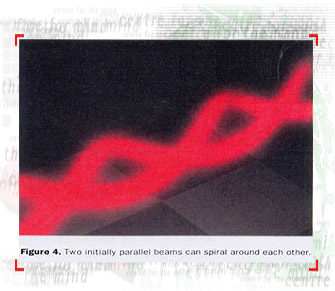
Such "big" incoherent solitons can be
very neatly viewed as being composed of an enormous number of
modes of the multimoded waveguide they induce. But, recall that
diffuse light propagation along multimoded waveguides can be described
by classical geometric optics. So incoherent solitons can also
be viewed as bundles of rays, each ray obeying the paraxial ray
equation, or equivalently as a bundle of classical (non-interacting)
point particles, each particle obeying Newton's laws of motion.
This leads to predictions that are unique to incoherent solitons.
For example, they can have any shape in their two-dimensional
cross-section, even travel in parallel without interacting, unlike
coherent beams in the same intensity dependent medium.
Temporal Solitons for Telecommunications
It is insightful to contrast spatial with temporal optical solitons.
Temporal solitons are pulses that propagate along optical glass
fibers[ ]for long distance telecommunications. Here the material
nonlinearity is only weakly perturbed. This is a one-dimensional
problem. Whereas, spatial solitons envisaged for device applications
in bulk material are typically quasi-monochromatic beams that
are localized in two-transverse dimensions and propagate only
for millimeters. These beams sufficiently alter the refractive
index of the bulk material to actually create their own waveguides.
The extra dimension brings additional riches such as the possibility
for beams to spiral around each other, but it also demands that
the nonlinearity be saturating or nonlocalized if the beams are
to be both stable and localized in space.
Device and Logic Applications: Switching Light with Light
The dream of photonics is to have a completely optical technology.
Here the traditional carriers of information, electrons, are envisaged
to be replaced by photons for devices based on switching and logic.
Spatial solitons offer one potential way to achieve this dream.
We have described how waveguides are induced by solitons. The
challenge is to develop methods for controllable steering of these
waveguides by light itself and to produce reconfigurable waveguides.
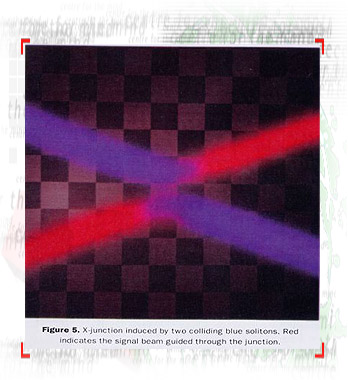
Because solitons can attract and guide beams, light can be used
to switch light for various device and logic applications which
are presently being performed by electronics. The solitons can
be considered as the information flow itself or as inducing optical
waveguides in which the information is carried. This information
can take the form of a weak ("dim") probe beam at a
different wavelength or different polarisation than the ("bright")
soliton beam. In either scheme, intricate virtual circuitry can
be written in bulk nonlinear media. Depending on the material,
the circuitry has a life span which allows for the possibility
of self-reconfigurable circuits. Such plasticity opens the door
to adaptive circuits that can be designed to transform themselves
to the desired application. We are led to the image of a transparent
cube with thousands of dynamically interconnected "wires"
all created, maintained and organised by light itself.
The speed required for switching depends on the application.
It can be as slow as seconds for circuit reconfiguration in network
application or as fast as picoseconds for optical computing. The
steering of one soliton by another or of a weak signal beam by
a soliton forms the simplest case of spatial switching. Alternatively,
the coupling ratio of a soliton induced coupler can be adjusted
by changing the pump signal in one arm. Structures can be created
to tap a signal, make a copy or reroute it and these processes
can be made dynamic. It is also possible for two colliding solitons
to fuse or for a soliton to be split into two solitons by a weak
probe beam, thus creating additional forms of spatial switching.
Designer components and light written circuitry
We have shown how soliton dynamics can be approached from the
perspective of linear waveguides. Curiously the reverse is also
true. The phenomenon of soliton dynamics provides a method of
actually fabricating waveguide components whose design had not
even been foreshadowed from our knowledge of linear waveguides.
The concept is elementary. Solitons are allowed to interact in
the appropriate photosensitive material so that the desired induced
waveguide configurations are then permanently written.
For example, consider the optical device known as the X-junction.
This is one of many building block components used for processing
optical signals. It can be used to mix or split two signals in
any desired proportion. Figure 5 shows a signal propagating
through a soliton induced X-junction. In this particular case,
the junction is designed to be completely transparent.
Light written circuitry offers potential advantages over the
more conventional fabrication processes such as ion diffusion,
PECVD, and sol-gel. In some materials beams fuse upon colliding.
But, unless beams collide at virtual grazing incidence, they always
pass through one another without influencing each other. In this
way it is possible to compress circuitry into a compact space
with many circuits sharing the same physical location. Furthermore,
certain photosensitive materials offer the potential for erasing
one light written device and replacing it by another. Hence, we
have the building blocks for dense reconfigurable virtual circuitry.
Conclusions
We have unfolded our dream of virtual circuitry. A transparent
cube with a myriad of interconnections created, maintained, and
arranged by light itself - with truly awesome potential. Will
all this lead to a viable technology? Some formidable challenges
remain in crafting the requisite materials, but the present situation
regarding light guiding light is reminiscent of the mid 1960's
when optical fibre communication was first being mooted. A great
idea, if glass absorption could be dramatically reduced. That
reduction came in only a few years. Where there is a will, there
is a way!
Scientists have been trying to confine light to artificial boundaries.
Here is the opportunity for light to be the master of its own
destiny.
Acknowledgements: Nail Akhmediev, Alexander Buryak, Barry
Luther-Davies, Yuri Kivshar, Wieslaw Krowlikowski and John Mitchell
contributed to the discussions presented here. Drew Whitehead
and Tim Thompson produced the scientific visualizations.
References
-
R.Y. Chiao, E. Garmire, and C.H. Townes, "Self-trapping
of optical beams", Phys. Rev. Lett. 13, 479-480
(1964)
-
Recent reviews include: M. Segev and G. Stegeman, "Self
trapping of optical beams", Physics Today 51,
42-48 (1998); B. Luther-Davies, J. Christou, V. Tikhonenko
and Yu. S. Kivshar, "Optical vortex solitons, JOSA B 14, 3045-3053 (1997); A.W. Snyder and Yu. S. Kivshar,
"Bright spatial solitons in non-Kerr material",
JOSA B 14, 3025-3031 (1997).
-
M. Mitchell and M. Segev, "Self-trapping of incoherent
white light", Nature (London) 387, 880-882 (1997)
-
Y.R. Shen, "Solitons made simple", Science 276,
1520 (1997); A.W. Snyder and D.J. Mitchell, "Accessible
solitons", Science 276, 1538-1541 (1997)
-
A.W. Snyder, D.J. Mitchell, and F. Ladouceur, "Self-induced
optical fibers: spatial solitary waves," Opt. Lett. 10,
21-23 (1991)
-
L. Poladian, A.W. Snyder, and D.J. Mitchell, "Spiralling
spatial solitions," Opt. Commun. 85, 59-62 (1991)
-
A.W. Snyder and A.P. Sheppard, "Collisons, steering
and guidance with spatial solitons," Opt. Lett. 18,
482-484 (1993)
-
W.E. Torruellas, Z. Wang, D.J. Hagan, E.W. Van Stryland,
G.I. Stegeman, L. Torner, and C.R. Menyuk, "Observation
of two-dimensional spatial solitary waves in a quadratic medium,"
Phys. Rev. Lett. 74, 5036-5039 (1995)
-
M. Shih, M. Segev, and G. Salamo, "Circular waveguides
induced by two-dimensional bright steady-state photorefractive
screening solitons," Opt. Lett. 21, 931-933 (1996)
-
M. Shih and M. Segev, "Incoherent collision between
two-dimensional bright steady-state photorefractive spatial
screening solitons," Opt. Lett. 21, 1538-1540
(1996)
-
V. Tikhonenko, J. Christou, and B. Luther-Davies, "Three-dimensional
bright spatial soliton collision and fusion in a saturable
nonlinear medium," Phys. Rev. Lett. 76, 2698-2701
(1996)
-
W. Krolikowski and S.A. Holmstrom, "Fusion and birth
of spatial solitons upon collision," Opt. Lett. 22,
369-371 (1997)
-
M. Shih, M. Segev, and G. Salamo, "Three-dimensional
spiralling of interacting spatial spatial solitons,"
Phys. Rev. Lett. 78, 2551-2554 (1997)
-
T. Thwaites, "Will optical fibres become obsolete?"
New Scientist, January 12, p. 14 (1991)
-
D.J. Mitchell, A.W. Snyder, and L. Poladian, "Interacting
self-guided beams viewed as particles: Lorentz force derivation",
Phys. Rev. Lett. 77, 271-273 (1996)
-
A.W. Snyder, S. Hewlett, and D.J. Mitchell, "Dynamic
spatial solitons," Phys. Rev. Lett. 72, 1012-1016
(1994); A.W. Snyder, D.J. Mitchell, and Yu. S. Kivshar, "Unification
of linear and nonlinear guided wave optics," Mod. Phys.
Lett. B 9, 1479-1506 (1995)
-
A.W. Snyder, L. Poladian, and D.J. Mitchell, "Stable
black self-guided beams of circular symmetry in a bulk Kerr
medium," Opt. Lett. 17, 789-791 (1992)
-
G.A. Swartzlander, Jr. and C.T. Law, "Optical vortex
solitons observed in Kerr nonlinear material," Phys.
Rev Lett. 69, 2503-2506 (1992)
-
N.N. Akhmediev, W. Krolikowski, and A.W. Snyder, "Partially
coherent solitons of variable shape," Phys. Rev. Lett.
in press (November 1998)
-
The concept of an incoherent soliton was first introduced
in the temporal domain: A. Hasagawa, "Dynamics of an
ensemble of plane waves in nonlinear dispersive media,"
Phys. Fluids 18, 77 (1975); Envelope soliton of random
phase waves, Phys. Fluids 20, 2155-2156 (1977); Self-confinement
of multimode optical pulse in a glass fiber, Opt. Lett. 5,
416-417 (1980). Segev's group was first to recognize the possibility
in space..
-
M. Mitchell and M. Segev, "Self-trapping of incoherent
white light," Nature 387, 880-882 (1997).
-
D.N. Christodoulides, T.H. Coskun, M. Mitchell and M. Segev,
"Multimode incoherent spatial solitons in logarithmically
saturable nonlinear media," Phys. Rev. Lett. 80, 2310-
2313 (1998); M. Mitchell, M. Segev, T. Coskun and D.N. Christodoulides,
"Theory of self-trapped spatially incoherent light beams,"
Phys. Rev. Lett. 79, 4990-4993 (1997)
-
A.W. Snyder, J.D. Love, Optical Waveguide Theory, Chapman and Hall (1983).
-
A.W. Snyder and D.J. Mitchell, "Big incoherent solitons,"
Phys. Rev. Lett. 80, 1422-1425 (1998)
-
A. Hasegawa, Optical Solitons in Fibers, Springer-Verlag,
Berlin (1989).
-
F. Ladouceur, D.J. Mitchell, and A.W. Snyder, "Optical
components induced by repelling solitons," JOSA B, 14,
1768-1771 (1997)
-
A.W. Snyder, A.V. Buryak, and D.J. Mitchell, "Beam
splitting on weak illumination," Opt. Lett. 23,
4-7 (1998)
Allan W Snyder holds the Peter Karmel Chair of Science and the
Mind at the Institute of Advanced Studies and is Head of the Optical
Sciences Centre. François Ladouceur is a Research Fellow
in the Optical Sciences Centre. Both are at the Research School
of Physical Sciences and Engineering, the Institute of Advanced
Studies, The Australian National University and both are part
of the Australian Photonics Cooperative Research Centre. |

